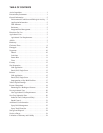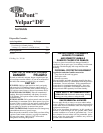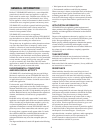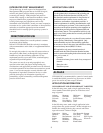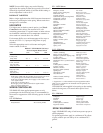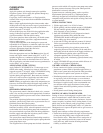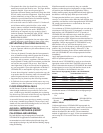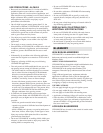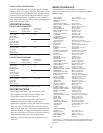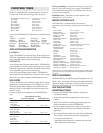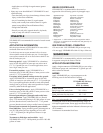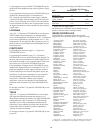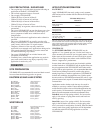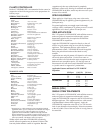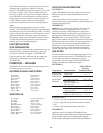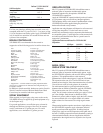
APPLICATION INFORMATION
DuPont™ VELPAR® DF may only be applied to pruned
blueberry fields in the spring before leaf emergence. Using
calibrated ground spray equipment, make the application in
sufficient water to provide thorough and uniform coverage
to the treated area (usually 20 gallons per acre). Shut off
spray booms when starting, turning, slowing or stopping, or
injury to the crop may result.
USE RATES (Lb/Acre)
HIGH BUSH BLUEBERRIES
less than or greater than
equal to 3% 3% organic
Soil texture organic matter matter
Coarse
loamy sand, 1.3 1.6
sandy loam
(50-85% sand)
Medium
loam, silt loam, 2.6
silt, clay loam,
sandy clay loam
Fine
silty clay loam, *1.3 - 2 2.6
clay loam,
sandy clay,
silty clay, clay
*Use the higher rate as the soil organic matter approaches 3%.
LOW BUSH BLUEBERRIES
less than or greater than
equal to 3% 3% organic
Soil texture organic matter matter
Coarse
loamy sand, 1.2 1.6
sandy loam
(50-85% sand)
Medium
loam, silt loam, 2
silt, clay loam,
sandy clay loam
Fine
silty clay loam, *1.2 - 2.4 2.4 - 3.6**
clay loam,
sandy clay,
silty clay, clay
*Use the higher rate as the soil organic matter approaches 3%.
**Use the higher rate for harder to control species.
USE PRECAUTIONS
• Do not apply through any type of irrigation system.
• Do not apply to flooded field with standing water.
• Do not apply within 450 days of harvest.
• Do not exceed 2.4 pounds per acre if field has been
treated with hexazinone within the past 8 years.
• Application to blueberry foliage will result in crop injury.
• Since the effect of VELPAR® DF on blueberries varies
with soil type, plant vigor, uniformity of applications and
amount of rainfall, it is suggested that growers limit their
first use to small areas. If excessive leaf drop is observed
after treatment, reduce rate in future applications.
• Maintain a 50 foot buffer from any well head or water
reservoir.
WEEDS CONTROLLED
VELPAR® DF is recommended for the control or
suppression of the following species in high and low bush
blueberry crops:
* Suppression – a visible reduction in plant population and/or plant
vigor as compared to an untreated area and generally not accepted
as control.
Aster, heath* Aster ericoides
Barnyardgrass Echinochloa crus-galli
Blackberry* (briar) Rubus spp
Bluegrass,
Kentucky (perennial)* Poa pratensis
Brome, downy (cheatgrass) Bromus tectorum
Broomsedge* Andropogon virginicus
Carrot, wild* Daucus carota
Catchfly, English Silene gallica
Chamomile, mayweed Anthemis cotula
Cherry, wild Prunus serotia
Chickweed, common Stellaria media
Cinquefoil Potentilla spp
Cockle, white* Melandrium album
Dandelion, common* Taraxacum officinale
Dandelion, false*
(spotted catsear) Hypochaeris radicata
Daisy, oxeye Chrysanthemum leucanthemum
Dock, curly* Rumex crispus
Dogfennel Eupatorium capillifolium
Fescue* Festuca spp
Fiddleneck, tarweed Amsinckia lycopsoides
Filaree Erodium spp
Fireweed*(willowweed) Epilobium angustifolium
Fleabane, flax-leaved Conyza bonariensis
Flixweed Descurainia Sophia
Foxtail, yellow Setaria lutescens
Goldenrod Solidago spp
Groundsel, common Senecio vulgaris
Hawkweed Hieracium spp
Horseweed/marestail Conyza canadensis
Jimsonweed Datura stramonium
Lambsquarters, common Chenopodium album
Lettuce, Miner’s Montia perfoliata
Lettuce, prickly* Lactuca serriola
Mustard, blue Chorispora tenella
Mustard, Jim Hill (tumble) Sisymbrium altissimum
Orchardgrass * Dactylis glomerata
Orchardgrass (seedling) Dactylis glomerata
Panicgrass (witchgrass) Panicum capillare
Panicum, fall Panicum dichotomiflorum
Pearly everlasting Anaphalis margaritacea
Pennycress, field Thlaspi arvense
Pigweed, redroot Amaranthus retroflexus
Quackgrass Agropyron repens
Radish, wild Raphanus raphanistrum
Ragweed, common Ambrosia elatior
Raspberry* (briar) Rubus spp
Rocket, London Sisymbrium irio
Rocket, common yellow Barbarea vulgaris
Ryegrass, Italian (annual) Lolium multiflorum
Ryegrass, perennial* Lolium perenne
Salsify Tragopogon spp
Shepherdspurse Capsella bursa-pastoris
Smartweed, Pennsylvania Polygonum pensylvanicum
Sorrel, red Rumex acetosella
Sorrel, sheep Rumex angiocarpus
Spurry, corn Spergula arvensis
Strawberry, wild Fragaria virginiana
Tansymustard (pinnate) Descurainia pinnata
Tea, Mexican* Chenopodium ambrosioides
Velvetgrass Holcus lanatus
Yarrow Achillea spp
2.4 to 3.6 Lbs/acre
Dogbane** Apocynum spp
Meadow-sweet Filipendula ulmaria
Blackberry, trailing Rubus ursinus
Laurel, sheep Kalmia angustifolia
Rose, wild** Rosa spp
8



